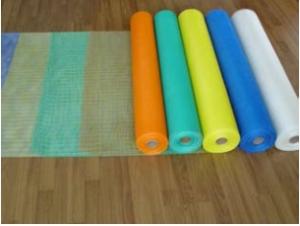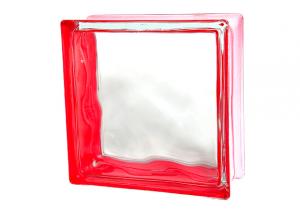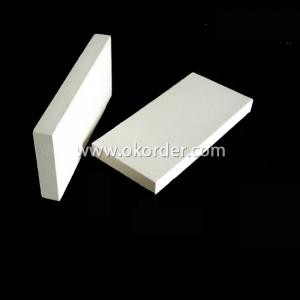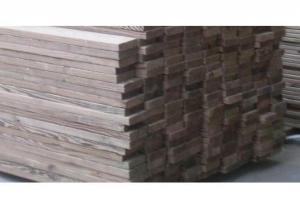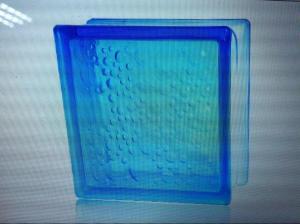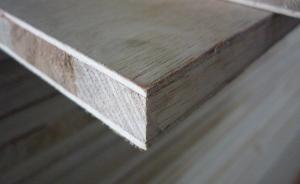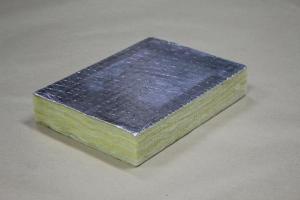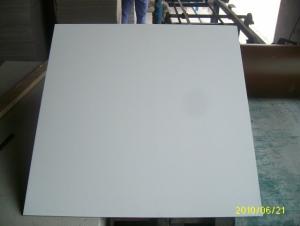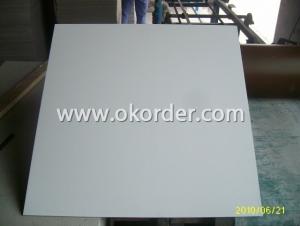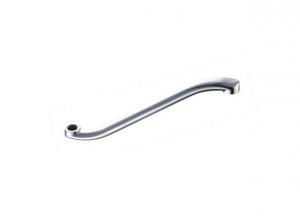Coated Alkali-resistant fiberglass mesh cloth (gram weight 125)
- Loading Port:
- China Main Port
- Payment Terms:
- TT OR LC
- Min Order Qty:
- -
- Supply Capability:
- -
OKorder Service Pledge
Quality Product, Order Online Tracking, Timely Delivery
OKorder Financial Service
Credit Rating, Credit Services, Credit Purchasing
You Might Also Like
Coated Alkali-resistant fiberglass mesh cloth is
based on C-glass or E-glass woven cloth and
treated by alkali-resistance copolymer resin on
the surface.
The woven cloth is made of fiberglass yarn or
roving by means of leno or plain weave.
The diameter of elementary fiberglass varies
between 9 and 15 micron.
The resin used for the surface treatment ensures
the property of alkali-resistance and increases
the mechanical durability that is required by the
construction industry.
- Q:What causes the geotextile aging phenomenon
- Gundam has the characteristics of the product we are all obvious, both in the highway, dams, railways and many other occasions have a very strong product features, and the performance is very outstanding, geotextile is an irreplaceable geotechnical material. Although the geotextile has unparalleled advantages, but the product is not perfect that any product has more or less problems or less, geotextile is the same, its aging problem has been with us, then in the end what causes Geotextile aging? Geotextile aging problem refers to the geotextile in the sun by the smell, temperature changes, biological erosion, chemical corrosion, moisture and other external factors, so that the geotextile strength and performance gradually weakened, loss of seepage effect. UV radiation intensity changes with the intensity of solar radiation, geotextile aging speed with the intensity of UV radiation and speed. Synthetic polymer polymer is concerned, the sun radiation is the main factor in the degradation of polymer degradation. UV radiation in the sun is the most important factor in the aging of the fabric. The ultraviolet radiation causes the polymer to produce a photooxidative decomposition reaction, especially ultraviolet light at a wavelength of 290 to 400 mPm, which has a significant decomposition effect on the polymer , Because the geotextile in the range of ultraviolet light energy is higher than the polymer chemical steamed broken the required energy, so the polymer material aging is very obvious.
- Q:He pushes a can over the scaffold at 15 meters and it takes 3.25 seconds for it to land.I keep doing the problem over and over. the Correct answer is 20.5 m/s, however I keep arriving to the solution of 17 m/s. I solved it by doing Vf^2 = Vi^2 + 2adwhere the initial velocity is zero and the acceleration is -g. I made my coordinate system so that down is negative in which the distance will be negative. This however, did not give me the correct answer. Am I right or is the book right?
- The initial velocity is not zero since the scaffold is moving upward when the can gets pushed over. And final velocity, vf, does not represent the speed of the scaffold (if that is what you're trying to solve). y = (vo)(t) - (1/2)gt? 15 m = (vo)(3.25 s) - (1/2)(9.81 m/s?)(3.25 s)? vo = +20.5 m/s
- Q:How to do with glass fiber wall anti-crack
- For glass fiber is also used to see you are used in the external walls or interior walls, wall materials are different, a lot of things are not applicable once. Do not apply their own norms. And a slap to shoot the whole law
- Q:How do geomembranes prevent further contamination in site remediation?
- Geomembranes prevent further contamination in site remediation by acting as a barrier between the contaminated soil or water and the surrounding environment. They are impermeable liners made of synthetic materials that are installed to prevent the migration of contaminants. By isolating and containing the contaminants, geomembranes help to prevent their spread and protect the surrounding soil, groundwater, and surface water from further contamination.
- Q:The metal net is arranged at the junction of the wall plastering, the frame column, the beam and the wall,
- Separate list, code multiplied by 0.3m, if the shop is plastered on the wall
- Q:In the home improvement of the kitchen with the best material, is the aluminum plate is good, or PVC board or aluminum plate is good
- Aluminum-plastic plate with aluminum plate, because the aluminum plate has a size specifications, a single use and can not be sure to meet the site construction
- Q:Can a waterproofing membrane be used in swimming pools?
- Indeed, the utilization of a waterproofing membrane in swimming pools is widespread. To avert water leakage, it is a customary practice to incorporate waterproofing membranes during the construction or refurbishment of swimming pools. These membranes possess an exclusive design that enables them to function as a barrier against water infiltration, guaranteeing the pool's impermeability and leak-free condition. Typically, these membranes are crafted from robust materials like PVC, EPDM, or polyurethane, which exhibit resistance to water, chemicals, and UV rays. Furthermore, their flexibility allows them to effortlessly conform to the pool's shape and contours, providing a seamless and enduring waterproofing solution.
- Q:What are the different types of stripping methods used with steel frame formwork?
- There are several different types of stripping methods used with steel frame formwork, including crane stripping, hydraulic stripping, and manual stripping. Crane stripping involves using a crane to lift and remove the formwork from the concrete structure. Hydraulic stripping utilizes hydraulic jacks to lift and separate the formwork from the concrete. Manual stripping involves manually dismantling and removing the formwork by hand. These methods offer varying degrees of speed, efficiency, and labor requirements depending on the specific project and requirements of the formwork system.
- Q:What are the considerations when selecting the appropriate steel grade for formwork?
- When selecting the appropriate steel grade for formwork, there are several considerations that need to be taken into account. Firstly, the load-bearing capacity of the steel grade is of utmost importance. The steel should be able to withstand the weight and pressure exerted by the concrete and any additional loads that may be applied during construction. It should be able to maintain its structural integrity without any deformation or failure. Secondly, the corrosion resistance of the steel grade is crucial. As formwork is often subjected to moisture and chemicals present in concrete, it is essential to choose a steel grade that can resist corrosion. This will ensure the longevity and durability of the formwork, avoiding any potential safety hazards or costly repairs. Another consideration is the ease of handling and fabrication. The selected steel grade should be easy to cut, shape, and weld, allowing for efficient and accurate construction of formwork. It should also have good dimensional stability, ensuring that the formwork remains in the desired shape and size during use. The cost-effectiveness of the steel grade is also a significant factor. While it may be tempting to opt for a higher grade steel with superior properties, it is essential to evaluate the project requirements and choose a grade that offers the necessary performance at a reasonable cost. This will help to optimize the budget without compromising on the quality and functionality of the formwork. Lastly, compliance with industry standards and regulations should be considered. The selected steel grade should meet the relevant codes and specifications set by governing bodies to ensure that the formwork meets safety standards and can withstand the intended loads and environmental conditions. By taking these considerations into account, one can select an appropriate steel grade for formwork that ensures structural stability, durability, corrosion resistance, ease of handling, cost-effectiveness, and compliance with industry standards.
- Q:How do geocells enhance the load distribution of soils?
- Geocells enhance the load distribution of soils by confining and stabilizing the soil within a three-dimensional honeycomb-like structure. This effectively increases the soil's bearing capacity and reduces deformation under load, as the geocells distribute the applied load evenly across a wider area. Additionally, the geocells prevent lateral movement of the soil particles, enhancing shear strength and reducing the potential for soil settlement.
1. Manufacturer Overview |
|
|---|---|
| Location | |
| Year Established | |
| Annual Output Value | |
| Main Markets | |
| Company Certifications | |
2. Manufacturer Certificates |
|
|---|---|
| a) Certification Name | |
| Range | |
| Reference | |
| Validity Period | |
3. Manufacturer Capability |
|
|---|---|
| a)Trade Capacity | |
| Nearest Port | |
| Export Percentage | |
| No.of Employees in Trade Department | |
| Language Spoken: | |
| b)Factory Information | |
| Factory Size: | |
| No. of Production Lines | |
| Contract Manufacturing | |
| Product Price Range | |
Send your message to us
Coated Alkali-resistant fiberglass mesh cloth (gram weight 125)
- Loading Port:
- China Main Port
- Payment Terms:
- TT OR LC
- Min Order Qty:
- -
- Supply Capability:
- -
OKorder Service Pledge
Quality Product, Order Online Tracking, Timely Delivery
OKorder Financial Service
Credit Rating, Credit Services, Credit Purchasing
Similar products
New products
Hot products

